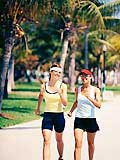Coronary artery patients should practice brisk walking
 People with coronary artery disease need to practice endurance exercises to improve heart function and blood supply to the agency. Quick walking is considered the ideal sport for them.
People with coronary artery disease need to practice endurance exercises to improve heart function and blood supply to the agency. Quick walking is considered the ideal sport for them.
Coronary artery disease (vascular nourishment of the heart muscle) occurs due to plaque causing narrowing of the lumen, resulting in the heart muscle not being supplied with enough oxygen and nutrients. The world's leading cardiologists affirmed that exercising sports is one of the most effective non-medicinal treatments.
Endurance training enhances the function of the heart's contractile function, improves myocardial oxygen absorption and uses oxygen more efficiently. In addition, durable forging exercises also stimulate the development of the collateral circulation of the heart muscle, improving blood supply to the heart muscle. Regular exercise reduces the frequency of the circuit in general and reduces the frequency of the circuit when performing the exercise, which allows the patient to raise the pain threshold when performing tasks in everyday life.
Fast and healthy walking reduces blood pressure in patients who exhibit hypertension (degree 1, 2) - a factor that promotes the development of the disease. This activity relaxes and increases the elasticity of blood vessels in active muscles, reducing peripheral blood resistance, resulting in lower blood pressure. But remember, it takes 3-4 months of regular exercise, blood pressure starts to drop and after 2-3 years of regular exercise, blood pressure returns to normal.
Regular exercise of forging exercise also effectively reduces weight, regulates blood fat, such as reducing cholesterol, triglyceride and increasing the amount of high molecular weight lipoprotein (HDL), reducing atherosclerosis, reducing risk of myocardial infarction.
The training program is personal, depending on the level of disease, signs of circulatory failure, the level of hypertension and other factors. In patients with angina, the stage of the disease must be determined. Do not practice if you have unstable angina (pain appears in a quiet state), acute heart attack, circulatory failure of 2-3 degrees or blood pressure increases above 180/100 mmHg.
Before the exercise program, the patient must be determined the amount of exercise by the standard labor test on bicycle dynamometer (conducted in the hospital). The pulse frequency during walking or running should be lower than the level that causes chest pain, difficulty breathing, or palpitations of 10-12 beats / minute. For example, if the force of the bicycle shows the chest pain when the circuit frequency reaches 125 beats / minute, when performing the exercise, the patient must control the speed so that the frequency of the circuit does not exceed 110-115 beats / minute.
The effect depends heavily on the speed of the exercise. To increase the speed of walking or running, before taking the exercise, the patient needs to take nitroglycerin, the analgesic effect of nitroglycerin lasts 30 minutes, enough to conduct a training session.
In the exercises of forging strength, brisk walking is the most suitable method for coronary artery patients because the motor intensity is not large and it is easy to adjust the motor dose. Early, 8-12 weeks, fast walking, then depending on your health, you may want to turn to alternating between brisk walking and small steps. Training time is 20-30 minutes / session, 5-6 sessions / week, or even the time of each training session about 20 minutes has also improved the general health status of patients.
If you experience heavy sensation in your chest, palpitations, difficulty breathing, fatigue or dizziness, you must slow down or stop exercising. If symptoms of angina appear, stop exercising and immediately take nitroglycerin.
Patients can participate in internship groups or practice at home according to an individual program. The program must be developed by physiotherapists and physicians. If possible, consult a doctor of sports medicine.
Dr. Dang Quoc Nam , Health & Life
- Extend the chance of life for diabetics
- Better walking than jogging
- Men are more susceptible to coronary artery disease than women
- Ultrasound inside the coronary arteries
- Children with Kawasaki are susceptible to coronary artery disease
- New technique of coronary artery: Five hours of surgery, ten years of health
- Walking like this, living for an additional 15-20 years
- Men with baldness are at risk for coronary artery disease
- The faster you walk, the longer you will last!
- Da Nang: A coronary artery bypass when the heart stops beating
- Interesting facts about ears most people don't know
- The culprit causes myocardial infarction
 Green tea cleans teeth better than mouthwash?
Green tea cleans teeth better than mouthwash? Death kiss: This is why you should not let anyone kiss your baby's lips
Death kiss: This is why you should not let anyone kiss your baby's lips What is salmonellosis?
What is salmonellosis? Caution should be exercised when using aloe vera through eating and drinking
Caution should be exercised when using aloe vera through eating and drinking